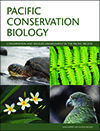The ecological impacts of invasive species are particularly evident on islands. One of the world’s most notorious invasive species is the cane toad (Rhinella marina), that was introduced to many Pacific islands early last century. Here, we review the ecological impacts of cane toads on islands, focusing on the Philippines.

Pacific Conservation Biology
Volume 28 Number 3 2022
PC21019Red hot frogs: identifying the Australian frogs most at risk of extinction
 , Conrad J. Hoskin
, Conrad J. Hoskin  , Deborah S. Bower, Renee Catullo, Simon Clulow, Michael Driessen
, Deborah S. Bower, Renee Catullo, Simon Clulow, Michael Driessen  , Katrina Daniels, Stephen T. Garnett
, Katrina Daniels, Stephen T. Garnett  , Deon Gilbert, Geoffrey W. Heard, Jean-Marc Hero, Harry B. Hines, Emily P. Hoffmann, Greg Hollis, David A. Hunter, Frank Lemckert, Michael Mahony, Gerry Marantelli, Keith R. McDonald, Nicola J. Mitchell
, Deon Gilbert, Geoffrey W. Heard, Jean-Marc Hero, Harry B. Hines, Emily P. Hoffmann, Greg Hollis, David A. Hunter, Frank Lemckert, Michael Mahony, Gerry Marantelli, Keith R. McDonald, Nicola J. Mitchell  , David Newell, J. Dale Roberts
, David Newell, J. Dale Roberts  , Ben C. Scheele, Michael Scroggie, Eric Vanderduys, Skye Wassens, Matt West, John C. Z. Woinarski
, Ben C. Scheele, Michael Scroggie, Eric Vanderduys, Skye Wassens, Matt West, John C. Z. Woinarski  and Graeme R. Gillespie
and Graeme R. Gillespie 
A recent assessment identified 45 Australian frogs as Threatened based on IUCN criteria. Using structured expert elicitation, we extend this work to identify the species that are in most immediate risk of extinction. Of the frogs assessed, eight (four of which may already be extinct) had high likelihoods of extinction (>50% chance), with a further five having a 30–50% chance of extinction by 2040. Increased resourcing and management intervention are urgently needed to avert future extinctions of Australia’s frogs. Key priorities include developing and supporting captive management and establishing or extending in-situ population refuges to alleviate the impacts of disease and climate change.
PC21019 Abstract | PC21019 Full Text | PC21019PDF (826 KB) | PC21019Supplementary Material (72 KB) Open Access Article
The lack of robust estimates of population density limits our capacity to identify and understand the decline of native mammals across northern Australia. We estimated northern brown bandicoot and common brushtail possum density on the Tiwi Islands (one of Australia’s few remaining refuges for native mammals). In doing so, we provide critical information for identifying and understanding future population change for two species that have suffered marked declines across the Australian monsoon tropics.
PC21020 Abstract | PC21020 Full Text | PC21020PDF (947 KB) Open Access Article
PC20036Industry environmental offset funding facilitates a large multi-species fauna translocation program
A large translocation effort in Western Australia released 975 individuals of six mammal and two bird species to areas they used to inhabit. Of 11 new populations, only two failed to establish. To our knowledge, this is the largest translocation effort ever undertaken in Australia and benefited four threatened species.
PC20036 Abstract | PC20036 Full Text | PC20036PDF (783 KB) Open Access Article
Quantifying the relative effects of factors that shape avian community composition and species abundances remains a significant conservation challenge. Sampling over 7 years during summer and winter periods in lowland floodplain forests highlighted the significant contribution of seasonal resources to community composition, and conservation reserves to protecting high quality habitats that maintain species abundances.
PC21009 Abstract | PC21009 Full Text | PC21009PDF (292 KB) | PC21009Supplementary Material (491 KB) Open Access Article
PC21015Phylogenetics of the skyhoppers (Kosciuscola) of the Australian Alps: evolutionary and conservation implications
 , Rachel A. Slatyer, Nikolai J. Tatarnic, Giselle R. Muschett, Shichen Wang and Hojun Song
, Rachel A. Slatyer, Nikolai J. Tatarnic, Giselle R. Muschett, Shichen Wang and Hojun Song
The true biodiversity of Australia’s alpine and sub alpine regions is unknown. Our study on flightless grasshoppers shows strong genetic structures and reveals many previously undescribed species. As climate change progresses quickly in the region, our study suggests management at fine geographic scales is crucial to conserve biodiversity.
PC21015 Abstract | PC21015 Full Text | PC21015PDF (3.4 MB) | PC21015Corrigendum (3.4 MB) | PC21015Supplementary Material (1.1 MB) Open Access Article
Effective environmental legislation that mitigates threats and strengthens protection are critical in arresting the decline of global biodiversity. We used the national listing of the greater glider, vulnerable to extinction under the Environment Protection and Biodiversity Conservation Act 1999 (EPBC), as a case study to evaluate the effectiveness of legislation for protecting threatened species habitat in Australia.
The current pandemic resulted in disastrous long-term changes for conservation. The Republic of Korea follows this trend and some activities such as mass culling of wildlife may even increase the risks of pandemic. Environmental protection will be the only safe way forward to proactively prevent the emergence of further pandemics.



